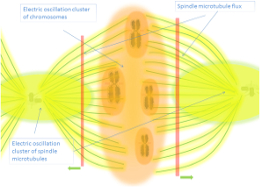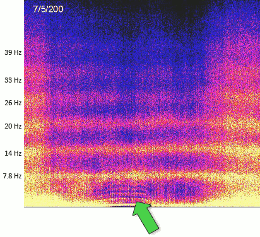

Electromagnetism & Cancer
The break of coherence of endogenous electromagnetic fields is the key precursor of cancer
Cancer is increasingly understood as a disease influenced by the disruption of endogenous electromagnetic (EM) fields. Evidence suggests that coherence and energy regulation in these fields play vital roles in maintaining cellular and tissue homeostasis. ...
This section synthesizes insights into the relationship between EM field disturbances and carcinogenesis, emphasizing experimental findings, bioelectric models, and potential interventions using coherent EM fields to restore systemic balance and inhibit tumor progression.
The origins of cancer have long been attributed to genetic mutations and biochemical abnormalities. However, a growing body of research highlights the role of physical and electromagnetic disruptions in carcinogenesis. This perspective views cancer as a result of decoherence in the bioelectric and electromagnetic fields that regulate cellular activities and tissue organization. This section explores how disruptions in these fields contribute to cancer development and discusses emerging therapeutic approaches leveraging coherent EM fields to combat malignancies.
Mechanisms of Electromagnetic Disruption in Cancer:
Decoherence of Endogenous Fields:
Cancer cells exhibit disrupted electromagnetic coherence, linked to mitochondrial dysfunction and the Warburg effect, where abnormal energy metabolism alters electromagnetic properties (Pokorný et al., 2020).
EM field disturbances in cancerous tissues result in impaired long-range interactions and reduced control over cellular organization, favoring random genetic mutations and malignant transformation.
Water Structure and Resonance Shifts:
Research indicates that the molecular structure of intracellular water changes from a hexagonal to a cubic phase in cancer cells, disrupting their resonant electromagnetic frequencies (Kalantaryan et al., 2024).
Tumor growth or regression is associated with the balance of resonant EM waves between healthy and cancerous tissues, influencing the electromagnetic environment at tumor boundaries.
Bioelectric Dysregulation:
Carcinogenesis is linked to the breakdown of bioelectric communication through membrane depolarization and disrupted ion channel function (Carvalho, 2022).
Bioelectric gradients, critical for tissue homeostasis, are altered in cancer, leading to unchecked cellular proliferation and a loss of organizational integrity.
Experimental Evidence of Electromagnetic Influence in Cancer:
Cancer-Specific Electromagnetic Signatures:
Studies using dielectrophoresis reveal that cancer stem cells have distinct electromagnetic properties compared to differentiated cells, reflecting changes in intracellular content and coherence (Barthout et al., 2022).
Biophotonic emissions in malignant cells differ in wavelength and intensity from non-cancerous cells, correlating with cellular stress markers and genetic activity (Murugan et al., 2023).
Tumor Microenvironment and EM Fields:
Measurements of electric fields around breast cancer tumors indicate inhomogeneous currents and voltage gradients, supporting the presence of endogenous electromagnetic circuits influencing tumor behavior (Zhu et al., 2020).
Disrupted electromagnetic signaling within the tumor microenvironment contributes to metastasis and resistance to conventional therapies.
Therapeutic Applications of Coherent EM Fields:
Restoration of Coherence:
Exposure to coherent non-ionizing electromagnetic fields has been shown to reestablish normal bioelectric states, suppressing tumor growth and enhancing tissue repair (Meijer & Geesink, 2017).
Therapeutic frequencies in the microwave and millimeter wave ranges have demonstrated the ability to reverse pathological water structures in cancer cells, restoring their hexagonal phase and reducing malignancy (Kalantaryan et al., 2024).
Bioelectric Modulation:
Targeting bioelectric signals, such as membrane potentials and ion channel activity, offers a promising approach to normalize cancer cells’ behavior and inhibit metastasis (Draguta et al., 2019).
Techniques like electric field therapy and bioelectric circuit manipulation aim to disrupt cancerous bioelectric patterns while promoting healthy tissue regeneration.
Electromagnetic Targeting in Cancer Therapy:
Enhanced electromagnetic fields generated by centrosome clusters in cancer cells have been exploited to attract magnetically charged nanoparticles for targeted drug delivery (Huston, 2015).
Advances in terahertz spectroscopy and imaging provide diagnostic tools to detect electromagnetic abnormalities in early-stage tumors, guiding personalized therapeutic interventions.
Discussion: The role of electromagnetic fields in cancer highlights the intersection of physics and biology in understanding malignancies. Cancer can be seen as a state of electromagnetic decoherence, where disrupted bioelectric and EM signaling undermines cellular coordination and tissue integrity. Addressing this decoherence through coherent electromagnetic interventions presents a paradigm shift in oncology, emphasizing systemic restoration over localized treatment.
Conclusion: Cancer’s association with disrupted electromagnetic fields underscores the importance of coherence in maintaining biological order. By leveraging insights into bioelectric and EM dynamics, researchers and clinicians can develop innovative therapies that restore systemic balance and inhibit tumor progression. Continued interdisciplinary research is essential to unlock the full potential of electromagnetic approaches in cancer prevention and treatment.
Keywords: cancer, electromagnetic fields, bioelectric signaling, coherence, tumor microenvironment, therapeutic frequencies, biophotons.
-Text generated by AI superficially, for more specific but also more surprising data check the tables below-Very related sections:
↑ text updated (AI generated): 23/12/2024
↓ tables updated (Human): 03/08/2025
Endogenous Fields & Mind
 EM & Cancer
EM & Cancer
.
.

























